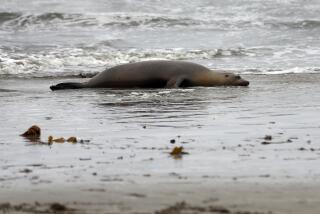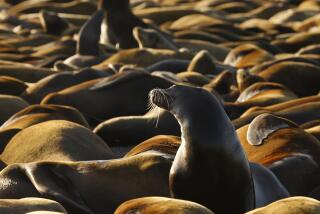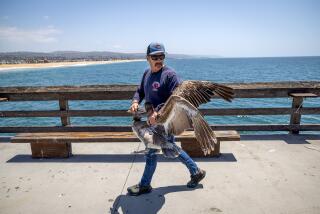Pelican Mutilations Return With Vengeance : Animal cruelty: After a lull, federally protected birds are again tortured by fisherman statewide. Atrocities are reported in Dana Point and Newport.
Linda Evans has nursed back to health many brown pelicans who have been intentionally burned, strangled and mutilated. But she has never been as shaken by an act of cruelty as she was on the morning of March 26, when she received a call reporting that a young pelican had been crucified alive on a light pole.
“I was horrified. It’s a feeling that comes from an act so ugly and awful you can’t even describe what goes on inside you,” said Evans, who runs the Pacific Wildlife Center, a Laguna Niguel sea bird rescue center. “I don’t understand how someone can do that to a living thing.”
Ten years after nearly two dozen pelicans were found with their beaks hacked off in Dana Point Harbor, the mutilations have resumed--this time along the entire Southern California coastline.
From Santa Barbara to San Diego, authorities say that over the past six months they have received roughly 30 reports of serious atrocities involving the federally protected species, including:
* In a rarely prosecuted atrocity, two pelicans were attacked and one killed by a fisherman in Dana Point Harbor. The incident was witnessed by two young Dana Point brothers, who reported the slaying to authorities. The fisherman was arrested and ultimately convicted on a cruelty-to-animals charge.
* The Newport Beach crucifixion, where a boatman motoring past the entrance to West Jetty Park spotted the pelican hanging from a light pole, its soft gullet and wings impaled on the large metal pins used for climbing, say authorities. The bird eventually died.
* About a half-dozen birds have been discovered with their beaks sawed off in Ventura, Redondo Beach, Marina del Rey and Dana Point this summer. Animal rescue volunteers say they have seen several more similarly mutilated birds floating beyond reach in the ocean.
* Two other criminal cases involving pelicans are being prepared by the U.S. Fish and Wildlife Service. In one incident, a deckhand on a commercial fishing boat grabbed a pelican by the beak with both hands and swung it like a baseball bat against a wall, then threw the seriously injured bird into the ocean.
The violence against pelicans ebbs and flows with El Nino, a climactic condition that occurs when, for unknown reasons, a much larger area of warm water develops off the coast of Latin America.
Experts say when the El Nino waters reached the California coast this spring, the herring and anchovies that form the mainstay of the brown pelican’s diet were driven away. Starving pelicans began flocking toward piers and marinas along the coast in search of food, bringing them into conflict with mankind, especially fishermen.
Unable to distinguish between fresh-cut bait and the fish they normally eat, the birds swoop onto the baited hooks of anglers--almost invariably snaring themselves on the barbed hooks in the process.
“The people who bill-chop or crucify these birds aren’t just acting out of frustration from losing (bait) fish,” said Paul Chang, special agent for the U.S. Fish and Wildlife Service, which--for the first time since the 1982 beak slashings--is offering rewards in hopes of stemming the mutilations. “This is real demented stuff. Somebody twisted enough to commit an act like that isn’t going away.”
At the worst point this summer, in early August, the number of injured pelicans cared for by the Pacific Wildlife Center in Laguna Niguel soared to 15 per day, from the center’s normal treatment rate of three birds a week. About the same time, the Santa Barbara Wildlife Care Network reported a similar surge. Although the numbers have since declined and leveled off, many pelicans are still recuperating at the two shelters and the memories remain vivid for shelter volunteers.
“Words can’t describe what was going on,” Evans said. “We were constantly sewing up pelicans, changing bandages on pelicans, feeding pelicans. It was like working in a MASH unit.”
Many of the injuries, Evans said, are attributable to thoughtless and occasionally malicious fishermen. Rather than slowly reeling in snared pelicans and carefully removing the hook, fishermen sometime just cut their lines. But the remaining lengths of fishing line often become snagged on rocks or pilings, or ensnarled around the birds’ wings. Immobilized, the terrified pelicans usually starve to death.
In the worst cases, the fishermen will just yank hard on the pole, tearing the hook from the soft flesh of the birds’ gullets, and frequently leaving large gashes or gaping holes. Again, the birds usually starve to death because the fish they catch and normally trap in their gullets slip through.
It is a violation of federal law to cause injury to or kill a protected species. The penalties can be heavy--fines up to $5,000, and jail terms up to six months. Civil penalties can reach $25,000.
But violators are seldom caught. “You have to be real lucky to catch someone in the act,” said Chang, one of seven federal Fish and Wildlife agents responsible for an area that stretches from Monterey to the Mexico border. “We’d really like to stick these guys, but it’s very rare that we can catch them red-handed.”
Chang depends on people who witness the atrocities to report them. Two youthful whistle-blowers, brothers Daniel and Matthew Lamb, aged 12 and 10 respectively, are responsible for the only successful prosecution in Southern California this year of someone who killed a brown pelican.
After saving their money for an inflatable raft, the brothers went for their maiden fishing excursion in Dana Point Harbor on the morning of July 7. Also fishing in a nearby canoe were Jeffrey McKinney, 20, and Mark McClelland, 26, both of Dana Point.
The men took several swings with an oar at two pelicans that had snatched their bait and gotten hooked, said Daniel Lamb. The first bird escaped with a broken wing but the second was killed by a single blow from McKinney.
“I was scared to say anything at first, but then I yelled at them to just cut the line,” said Daniel Lamb. One of the men “just said, ‘That hook’s worth more than the pelican.’ ”
After the bird died, McKinney and McClelland paddled away. The Lamb boys raced to shore and ran to an Orange County Sheriff’s Harbor Patrol office and reported the incident.
Both men were arrested, although charges against McClelland were dismissed. McKinney pleaded guilty to misdemeanor animal abuse charges and was sentenced to one year’s probation and 10 days of public service work at the South County Municipal Courthouse.
McKinney recently moved out of the area, according to his fishing buddy and former roommate McClelland. The hotel worker said the Lamb boys lied out of spite stemming from a charity benefit this summer. McClelland said he and McKinney were on the winning side of a tug-of-war in which the boys’ older brother, Mike, was a member of the losing team. The parents say Mike Lamb wasn’t at the event.
“But anyhow, I want to make it clear,” McClelland said. “I’m not a bird- or an animal-hater. I have respect for the ocean.”
Chang said the Lamb boys will split about $1,000 in reward money.
“Those kids showed a lot of guts turning in men who are twice their size,” he said. “I wish more people showed their courage.”
The brown pelican has evolved little in the 40 million years it has been known to inhabit Earth, scientists say. But the last quarter-century has been the roughest for them.
Years of DDT contamination of ocean waters off Southern California starting in the late 1940s was picked up by fish eaten by pelicans, which impaired the ability of the females to produce calcium, and thus weakened their eggshells. The thinner shells were crushed in the nest before the chicks were sufficiently developed to hatch. The species was found to be on the brink of extinction and was extended endangered species protection in 1970.
The birds still hadn’t recovered by the fall and winter of 1982-83, when the El Nino waters last appeared off the California coast. The resulting shortage of their customary food caused drastic reductions in their population. By 1984, their primary breeding spot, Anacapa Island, which is 30 miles due west of Malibu, saw only 628 nests built and 530 hatchlings. But when the effects of the El Nino completely disappeared the next year, those numbers skyrocketed to 5,148 nests that produced 6,387 baby pelicans.
Mankind wasn’t helping. In addition to the Dana Point mutilations, a Redondo Beach bait vendor was convicted in 1983 of electrocuting seven pelicans with a device he had built to protect his bait containers. The 68-year-old culprit in this case was jailed for seven days and put on probation for an additional three years. In Huntington Beach the same year, a boat captain pleaded guilty and was fined $1,200 for using pliers to torture and kill a brown pelican.
Further north in Monterey, 30 pelicans were found mutilated, most of them slashed in the neck and pouch with a knife. Authorities suspected that many of the slashings were the work of one person, but even a $20,000 reward contributed by outraged citizens didn’t succeed in determining the identity of an attacker.
Often, the group expressing the most outrage over pelican atrocities is the fishing community itself.
Outside Turk’s bar in the Dana Point Harbor, a popular watering hole for sailors and fishermen, Norm Hackbarth took note of the mutilations and snorted in disgust.
“Anybody that would do those kinds of things to a pelican ain’t no fisherman. Those people are sick,” said Hackbarth, a regular at the harbor who recalls first coming here in 1948. “They don’t hurt anything and they don’t eat that much fish. But some people think they own the sea and everything in it.”
Dan Askew is a weekend sport fisherman who takes charters from both Dana Point and Newport harbors. Sometimes, it’s hard to look at pelicans who are obviously in bad physical shape, he says.
“They get real close to the boats. Sometimes they land on the boat and walk right up and you can see these rusting hooks dangling from them,” Askew said. “I saw one that must have had six hooks on him. I’ve never seen anyone hurt one of these guys, but if I did, I think I’d walk up and hit ‘em.”
Volunteer bird rescuers say they have learned that confrontation is not the best policy with angry fishermen.
When Estelle Bush walks the beaches of Santa Barbara looking for injured sea birds, she says fishermen sometimes yell at her to throw them back in the water.
“I go to them with a smile on my face, but inside, I’m shaking and I just want to punch them out,” said Bush, who runs the Santa Barbara Wildlife Rescue Network. “But if I did that, they’d go out and injure birds just to get even.
“If you talk decently to them, you can get somewhere. One man once walked up to me and told me, ‘Get these birds the hell out of here.’ But the next week I saw him and he told me that he had taken hooks out of six birds.”
The good news is that despite being poisoned, starved, mutilated and fouled by oil slicks, the brown pelican is in no immediate danger of extinction, said Fred Gress, a research biologist with UC Davis. In the late 1960s and early 1970s, the population of brown pelicans in Southern California is believed to have shrunk to about 2,000 birds. Over the past 20 years, however, their numbers have increased to between 20,000 and 30,000.
“Overall, they’re not in a precarious situation at all,” said Gress, who has been studying brown pelicans for over 25 years.
But the birds that breed in Southern California--that are the most susceptible to the occasional visits of El Nino--are less fortunate than their brethren up the coast, that can migrate to the waters off Oregon and Washington in search of food.
“If there’s any precarious group, it’s those who breed in Southern California,” he said.
Gress makes annual trips to Anacapa Island, the Santa Barbara islands and other secluded places where pelicans breed. He uses a small skiff to visit the offshore islands where he counts the nests and the number of young. He has kept statistics on the birds since 1968.
On one recent journey, he plucked a pelican out of the ocean that appeared near death.
“I took 11 hooks out of him,” Gress said. “He was wrapped in monofilament (fishing line) and parasites were all over him. I took the hooks out and cleaned him up but I remember thinking he was going to die in a few days.
“A couple of months later I saw him again and damned if he didn’t look in pretty good shape. Pelicans can be pretty tough.”
Getting Them Off the Hook
A common misconception among fishermen is that it’s safe to leave a hook in a pelican because the hook will eventually rust and disintegrate. What to do if you find a pelican at the end of your line:
Securing the Pelican
1. Reel in your line smoothly and firmly, taking care not to break it. Even though the bird may be struggling and flapping its wings, the pelican is harmless when handled properly.
2. Grab the bird’s bill, close it and hold it securely with one hand. The inside edges of the bill are sharp; don’t rub your hand up and down the edge.
3. With your other hand, fold the wings and hold them in their normal closed position. This should calm the bird.
4. Turn the bird’s head around so it lies along the middle of its back (don’t worry; that’s how they sleep). Tuck the pelican under your arm or between your legs while removing the fishing line and hook. Keep a firm grip on the bill.
*
Removing the Hook
* If the hook is embedded in the bird’s flesh, try to cut off the barb and back out the hook. When that’s not possible, cut off the loop end of the hook and push the rest of it through. If you have no cutters, remove as much of the line as possible. Do not throw it back in the water, where it can snare another bird or foul a boat propeller.
* Push the hook forward so the barb end does not re-enter the bird’s flesh. Release the bird and step back a few feet. Do not rip out the hook.
* If your efforts to remove the hook seem to be causing the pelican further injury, take the bird to a lifeguard station or the Harbor Patrol.
El Nino Effect: When the warm El Nino waters arrive off the coast of Southern California, the Pacific herring and anchovies that are a staple of the brown pelican’s diet are driven away. Parenting birds must range farther from nests searching for food. A look at what has occurred on Anacapa Island, the major breeding ground for pelicans in Southern California:
*
Pelican Etiquette
* Don’t feed pelicans by hand. They are not considered dangerous, but hand-feeding causes them to flock together. That can allow disease to run through the flock and encourages the birds to stay by piers and wharves and not go out to the ocean to breed.
* Don’t engage in chumming (throwing out live bait to attract game fish) close to pelican colonies. It encourages the same behavior.
* Do squirt water from a hose to drive pelicans away from a boat, dock or pier area.
* Do report any pelican abuse or injured birds to the Harbor Patrol or lifeguard station.
Sources: UC Davis research biologist Frank Gress; Los Angeles Times research
Researched by FRANK MESSINA / Los Angeles Times
More to Read
Sign up for Essential California
The most important California stories and recommendations in your inbox every morning.
You may occasionally receive promotional content from the Los Angeles Times.










